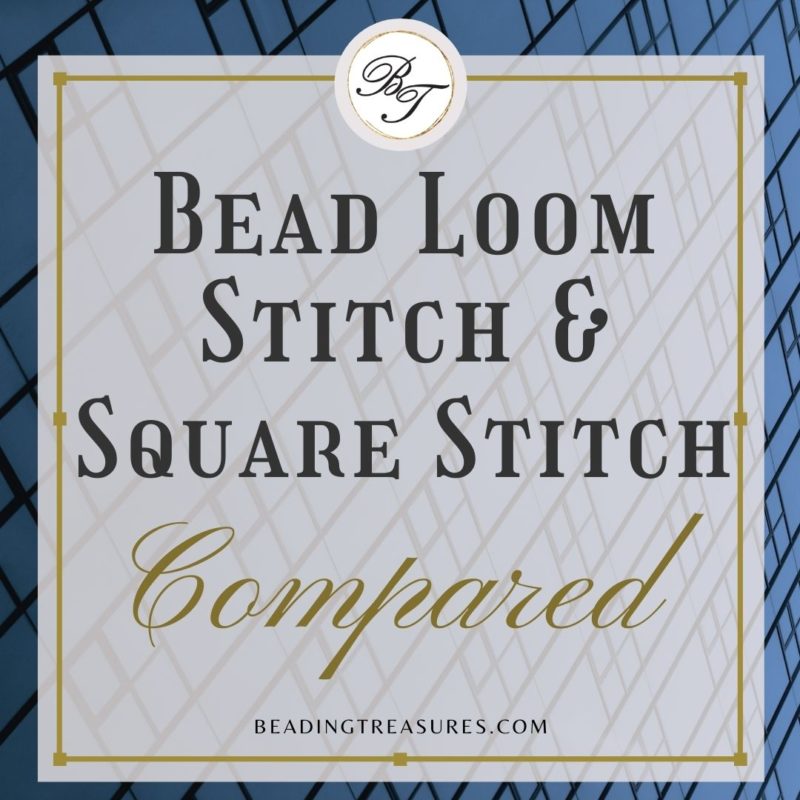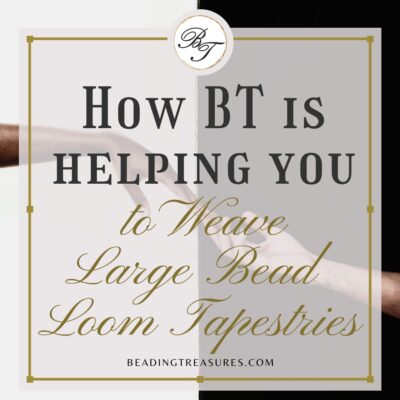Informative
Bead Loom Stitch and Square Stitch Compared
Follow us on
Estimated reading time: 9 minutes
Why bead weave on a loom when you can simply use another off-loom stitch like the square stitch in particular and achieve almost the same kind of result?
In this blog post, I’ll be comparing loom weaving to square stitch weaving.
I’ve chosen to compare these two stitches because the beads lie the same way in both, they are aligned in a grid.
After listing the pros and cons you will be able to make an informed decision as to which stitch suits you best.
But if you are interested read to the end and I’ll tell you all the reasons why I personally prefer weaving on the loom.
Loom Stitch and Square Stitch… What do they have in Common?
- The tapestries created by using either of the stitches look almost identical with minor differences.
- Both produce a beaded flexible fabric created from a grid pattern.
- The pattern could be designed for bead looming or cross-stitch embroidery patterns can be used.
All about Loom Stitch
It takes a bit longer to start the actual weaving or loom stitch.
The loom needs to be set up first with all the warps needed. But once that stage is done, the loom stitch is much faster than the square stitch.
This is especially true if you are working off a detailed pattern for a big tapestry where there is a larger number of colors needed.
Picking up the beads according to the pattern goes faster than having to pick up the beads one at a time and weave them in.
The loom stitch allows for using multiple or thicker threads on the sides of the tapestry to make it stronger.
With the loom stitch, the tension is mostly managed by the loom itself. No need to tug and pull to get the tension even with every bead.
This can be such a strain on the hands and the arms, especially if you have RSI( Repetitive Strain Injuries. This stitch only needs you to adjust the tension per row of weaving, as opposed to every single bead.
Because there are fewer passes through the beads, a thicker thread can be used for looming.
All about Square Stitch
All that is needed to get started with your Square Stitch bead weaving is a needle, thread, beading mat or tray, and your beads. Let’s not forget your pattern.
There is no setting up and warping of the loom, so you are up and running in no time.
You will love this stitch if weaving all the warp thread is something you really do not to deal with.
Although in my online learning lessons (still in the planning stages) I will have a technique that makes this phase of bead weaving easier and dare I say enjoyable.
With this method, I have finished 600 warps in a couple of hours.
Weaving on the go?
With the square stitch, you will not need to carry a loom around.
It is much easier to take your weaving with you wherever you go.
Because of the multiple passes of the thread through the beads with the thread going up and down in between the beads, these threads are more visible with this stitch.
Sometimes this can be managed with changes of the thread but not in the case where there are translucent beads or contrasting bead colors.
Having said that, the best color to use, so that the color of the beads used will translate best, is white. In most cases, that will be visible in between the beads (Where the warps are in the Loom Stitch).
Pros & Cons
Both of these stitches help to get a pattern as if you were using the cross-stitch embroidery technique.
Another benefit of these techniques is that your beading does not change whether you have an even or an odd number of beads in a row, this is important if you want to have a symmetrical pattern.
Now let’s list the pros and cons of each…
Loom Stitch Pros & Cons
Pros
Once the weaving is started it is so much faster.
Picking up all the beads needed for the row is done all at once.
Weaving the whole row at a time as opposed to one bead at a time.
Less wear and tear on the needles, and no need to replace them as often.
The loom will take care of most of the tension, no need to pull so hard.
Cons
Equipment is needed, such as the Bead Loom
Longer set-up time, for example, warping the loom.
Warp ends need to be managed once the tapestry is completed.
Steeper Learning curve to learn the stitch.
Square Stitch Pros & Cons
Pros
No loom is needed.
Easily transportable
Shorter learning curve
No warp ends to deal with once work is completed
Cons
Beading needles need to be replaced more often because they get bent.
The thread rubs against the side of the beads, and some beads have sharp edges that may cause the thread to fray.
More pulling is needed to keep the tension even, so there is more strain on the hands and the arms.
The thread is visible from in between the beads.
Working with one bead at a time, referring to the chart, picking the bead up, and then weaving it in.
The proof is in the sample
Samples of Loom Stitch and Square Stitch
Let’s compare the samples side by side, using the same thread and beads. They are very similar in size. Here is how they look.
Here I am using Delica 11/0 DB1503 beads and Nymo B in White for the thread for both samples.
Both samples are 10 beads wide and 9 beads tall.

As you can see the loom stitch sample on the left is much more even in shape and the sides are not bulging out.
Also, there is less space taken up on the sides of the beads by the thread, so the beads fit better side by side.
In all honesty, the bulging of the side in the square stitch sample could have been caused by tucking in the start and end thread into the first few rows of the beads. And I do have more experience with loom stitch.
Why do I prefer the loom stitch?
First, let me say that square stitch is my second favorite after loom stitch, of course.
Nothing beats loom stitch for me. I could go on and on but I’ll just list a few reasons here.
I really love working with the loom. I enjoy the meditative quality of the whole process. One needs to be calm and one needs to focus to do the work properly, and that helps me to slow down in this hectic world we live in.
The loom takes care of the tension needed for a good bead tapestry, which means no pulling and tugging on every bead, which translates into less pain from RSI (Repetitive Strain Injury) in my elbow. I am currently using the DIY bead tapestry pipe loom that I designed and built myself, for a fraction of the cost of looms of its type and size available on the market today, and I love it.
There is a certain satisfaction in knowing that I have my own space and place in front of the loom, and it is always reserved. For me.
The loom is this mysterious gizmo that one needs to learn how to use but is so fascinating to watch when weaving is in progress, and I use it to create my artwork.
I always get questions about what I am doing and how it all works, the loom seems to impress people.
The loom… my faithful, silent assistant holding my work for me and retaining the tension until I am ready to resume working on my tapestries.
So which to choose?
Loom or Square stitch?
It all comes down to personal choice. What works for you? If you are like me and have Repetitive Strain Injury (RSI)…. otherwise known as Tennis Elbow, the loom might be a better choice.
If you are always on the go and don’t want to have to deal with transporting a loom, then the square stitch is for you.
Whatever your choice, the same patterns can be used for both.
The final results will be almost identical.
Weaving a tapestry takes time, you might as well enjoy the process.
Choose what brings you joy.
If you enjoyed this post…
You might also like to read these posts too:
lATEST POSTS
Best Thread Color to Use with your Patterns
What is the best thread and thread color to use for weaving your bead tapestry?
Dec
Best Way to Weigh Your Beads
How best to go about weighing the beads in your stash before purchasing more for[...]
Dec
How BT is Helping You to Weave Large Bead Loom Tapestries
All things beading, bead looming large tapestries and digital planning for beaders.
Mar
Hi there ! I’m Nedal.
I created Beaded Treasures to make information about beading large tapestries more accessible, and in doing so encouraging creating of this amazing art form.
Weaving big can seem intimidating but by using some techniques it is totally doable, no more than that it is really enjoyable!
If you’ve found this blog helpful, please support me by choosing the affiliate products on my blog and following me on my social platforms.
Don’t forget to check out the shop.
Thank you!
Nedal Douaihy, Artist & Founder









